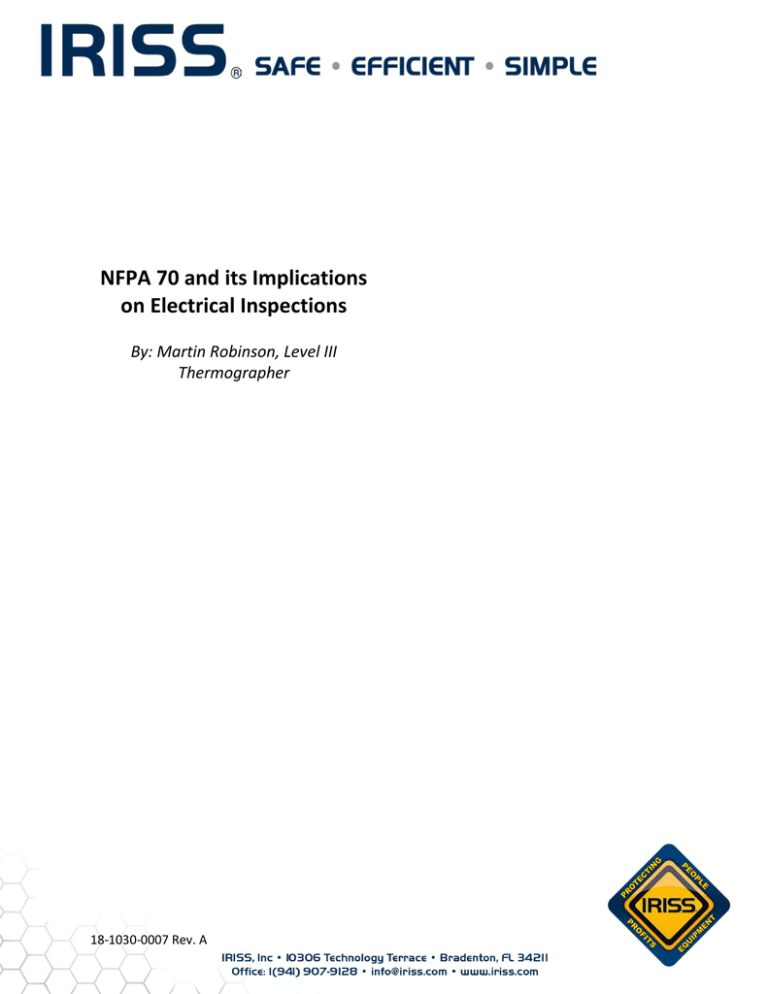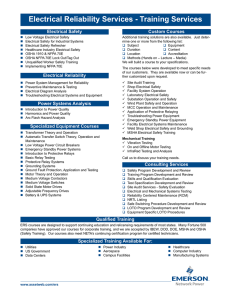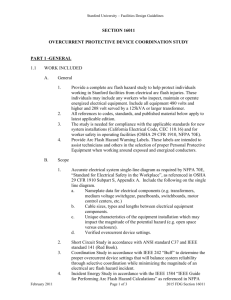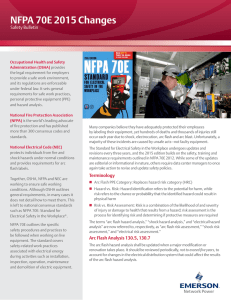NFPA 70 and its Implications on Electrical Inspections
advertisement

NFPA 70 and its Implications on Electrical Inspections By: Martin Robinson, Level III Thermographer 18-1030-0007 Rev. A The National Fire Protection Association (NFPA) was established in 1896 and has become the world’s leading advocate of fire prevention. The influence of its 300 codes and standards are evident in buildings, products, and practices throughout the world. NFPA codes are adopted through a broad consensus of experts, and have resulted in some of the world’s most referenced and respected codes. NFPA 70, also known as the National Electric Code (NEC) is the standard developed for electrical design, installation and inspection. It does not specifically address electrical maintenance or safe work practices. For the consensus standards on these topics we turn to NFPA 70B and NFPA 70E respectively. Although NFPA has no regulatory authority, its codes and standards are widely adopted or referenced by agencies such as local municipalities and OSHA – many times making the standards a de-facto regulatory requirement for companies. In fact, in August 2007, OSHA adopted aspects of NFPA 70E and the NEC in a rare revision to its (OSHA’s) 1910.303 Subpart S, stating that the agency will “draw heavily from” the 2000 edition of NFPA 70E, as well as the 2002 edition of the NEC. In other instances, insurers may reference standards as best management practices and may even require aspects of these standards as a requirement for better rates or perhaps as a prerequisite for insurability. Many insurers are requiring manufacturers to inspect their critical electrical distribution equipment at least annually, per NFPA 70B. Dangers of Arc Flash One of the dangers which these standards are designed to mitigate is the risk of an electrical arc flash. An arc flash is a short circuit (a phase-to-phase or phase-to-ground fault) through the air. Arc flash incidents can be triggered by a variety of electro-mechanical and accidental causes including: dust, corrosion and impurities on contact surfaces; racking of breakers and replacement of fuses; failure of insulating material; leads breaking at connections; accidental contact with conductors with body, tools, bolts or other metal parts. The arc flash itself can achieve temperatures in excess of 35,000F, producing a blinding flash, causing copper bus-bar and cabling to instantly reach a plasma state (the fourth state of matter after liquid and gas) which causes copper to expand more than 67,000 times its solid-state size. This resulting “arc blast” is a bomb-like explosion which releases thousands of pounds of force, carrying with it molten shrapnel and a super-heated fireball which will often blow steel panels off hinges and bolts. The net result can be total destruction of any plant assets in direct contact with the explosion, and disruption of plant processes. If a thermographer, electrician or laborer happens to be working in front of the equipment which is affected by the blast, the effects for the worker and their families could be devastating. The heat generated by the arc flash can cause 3rd degree burns. The pressure wave from the explosion can rupture internal organs, damage hearing and cause injuries if the worker is thrown into surroundings predominated by concrete and steel. The shrapnel and flying panels can have obvious effects as they rip through the air and potentially through any people in the vicinity of the explosion. Each year across North America, 5 to 10 serious arc flash incidents occur each day, resulting in the need to treat over 2,000 workers in burn centers (it is estimated that many more occur which only require emergency room attention and therefore do not get categorized in studies). The financial costs of flash accident are estimated in the hundreds-of-millions of dollars a year, while the effects on those workers and the lives of their families cannot be represented in mere dollars and cents. NFPA 70B NFPA 70B is a standard for implementing an effective Electrical Preventive Maintenance (EPM) program. “The purpose of an EPM program is to reduce hazard to life and property that can result from the failure or malfunction of electrical systems and equipment.” It states that “a well-administered EPM program will reduce accidents, save lives, and minimize costly breakdowns and unplanned shutdowns of production equipment…Without an EPM program, management assumes a greatly increased risk of a serious electrical failure and its consequences.” 70B goes on to state that “dependability can be engineered and built into equipment, but effective maintenance is required to keep it dependable.” “Electrical equipment deterioration is normal, but equipment failure is not inevitable. As soon as new equipment is installed, a process of normal deterioration begins. Unchecked, the deterioration process can cause malfunction or an electrical failure… An effective EPM program identifies and recognizes these factors and provides measures for coping with them.” 70B outlines the following benefits of an EPM program: • • • • • • Asset Protection: “Experience shows that equipment lasts longer and performs better when covered by an EPM program.” Risk Management: “An EPM program is a form of protection against accidents, lost production, and loss of profit.” Energy Conservation: “Equipment that ΔT Range Interpretation Prescriptive Action is well maintained operates more efficiently and utilizes less energy.” 1°C (1.8°F) to Indicates Possible warrant investigation Increased uptime and profitability: Deficiency 3°C (5.4°F) through “reduced interruption of production” and “better workmanship repairs should be made 4°C (7.2°F) to Indicates Deficiency and increased productivity.” as time permits 15°C (27°F) Improved employee morale and reduced absenteeism Indicates Major repairs should be made 16°C (28.8°F) Possible reduction in insurance costs: Deficiency immediately and above due to the alternative “high cost of inadequate maintenance.” NFPA regards systematic and regular thermographic electrical inspections to be a critical part of an EPM program stating that “these [thermographic] inspections have uncovered a multitude of potentially dangerous situations. Proper diagnosis and remedial action of these situations have also helped to prevent numerous major losses…They can reduce typical visual examinations and tedious manual inspections and are especially effective in long-range detection situations.” It goes on to endorse Thermographic electrical inspection as “relatively inexpensive to use considering the savings often realized by preventing equipment damage and business interruptions… [and is] considered a useful tool to evaluate previous repair work and proof test new electrical installations and new equipment still under warranty.” The 70B standard prescribes “routine infrared inspections of energized electrical systems should be performed annually prior to shutdown. More frequent infrared inspections, for example, quarterly or semiannually, should be performed where warranted by loss experience, installation of new electrical equipment, or changes in environmental, operational, or load conditions.” 70B also prescribes temperature benchmarking and references the NETA benchmarks as seen in Table 1. The NETA table compares temperatures to “normal” (as “determined by a qualified technician”) and prescribes a corrective action based on those deviations from “normal.” It is important to remember that temperature (T) and differential temperature (ΔT) measurements are only as accurate as the optic through which the object is being viewed. Therefore, it is imperative that users of infrared windows or viewing panes compensate for any attenuation in transmission. The standard is also very specific about performing “running inspections” (inspections made with equipment operating) and requires that “infrared surveys should be performed during periods of maximum possible loading but not less than 40 percent of rated load of the electrical equipment being inspected.” In instances where IR Windows or viewing panes are not available, “equipment enclosures should be opened for a view of components whenever possible...” since it is not possible for infrared imagers to calculate internal temperatures through standard panel covers or standard materials used in visual inspection panes (i.e. Tempered glass or Plexiglas) as these materials are non-transmissive in the infrared spectrum. Of course, when thermographers and electricians open electrical panels to perform thermographic inspections per NFPA 70B guidelines and insurance requirements, they increase the risk of allowing one of these triggers to occur. NFPA 70E rates the removal of bolted panels on electrical equipment to be in the highest hazard/risk category. Consequently, NFPA 70E standards for electrical safety must be adhered to. NFPA70B was recently revised. Changes in the 2010 edition include: • • • • Reorganization of document, including grouping of related topics plus consolidation of testing information New material on emergency preparedness and electrical system and equipment restoration New recommendations on how to conduct outsourcing of electrical equipment maintenance New information on failure modes effects and criticality analysis (FMECA) NFPA 70E Originally chartered in 1976 and first released in 1979, the 70E standard is “intended for use by employers, employees, and OSHA.” Its purpose was to assist OSHA in preparing a set of consensus standards to be used as a basis for evaluating electrical safety in the workplace. Through its eight revisions over roughly 30 years, the NFPA 70E Standard has made an indelible mark on safe workpractices throughout the US and throughout the world, although its greatest impact has only been recognized since the 2000 revisions which included clarification of PPE (personal protective equipment) requirements. In part, the current 70E Standard requires employers to: • • • • • • Perform a Flash Hazard Analysis to define Arc Flash Boundaries and document the incident energy levels of related equipment or consult the 130.7(C)(9) tables Provide workers with appropriate levels of PPE Allow only qualified personnel to work on or near live parts Train workers on electrical safety and safe work-practices Use safety signs, symbols and accident prevention tags Provide tools for safe work Hierarchy of Control At the heart of NFPA 70E and OSHA initiatives is the hierarchy of control (as referenced in Annex F of the 2009 edition of 70E). Put simply, this concept attempts to control or mitigate risk wherever possible. In order of preference, the hierarchy of control seeks to mitigate risks by: 1. Risk Elimination 2. Substitution (with lower risk) 3. Engineering Controls (such as arc resistant switchgear) 4. Safe Work Practices 5. PPE In short, the best way to reduce risk is to eliminate it. This is why NFPA 70E and OSHA state very plainly that electrical equipment should be de-energized prior to opening. Realizing that this is not always possible for troubleshooting, inspecting or in situations where shutting down is not viable or poses a risk, there is an allowance made for PPE to be used as a last resort – similar to the least preferred method in the hierarchy of control. The OSHA 1910.303 Linhardt Interpretation states clearly that “…with respect to arc-flash burn hazard prevention, the general provisions for the Selection and use of work practices... generally require de-energization of live parts before an employee works on or near them.” Although OSHA recommends that “employers consult consensus standards such as NFPA 70E-2004,” they fall short of fully endorsing the 130.7(C)(9) charts for PPE recommendations. Furthermore, they are on record in the Linhardt Interpretation as saying that some of the PPE protection and lack of lockout/tagout (LOTO) requirements do not offer workers as much protection as offered in Subpart S. Keep in mind that OSHA’s mandate to employers is to eliminate risk of work-place injury wherever possible and practical. To this end, PPE will always fall short of OSHA’s goal of zero-tolerance. The 2009 edition of the 70E (130.7(A) FPM No.1) plainly states the limits of PPE: “The PPE requirements of 130.7 are intended to protect a person from arc flash and shock hazards. While some situations could result in burns to the skin, even with the protection selected, burn injury should be reduced and survivable. Due to the explosive effect of some arc events, physical trauma injuries could occur. The PPE requirements of 130.7 do not address protection against physical trauma other than exposure to the thermal effects of an arc flash.” NFPA 70E & Thermography: New language has been introduced into the 2009 edition of NFPA 70E. Among other changes, the most notable for thermographers is the addition of infrared thermography as a task noted in the Hazard/Risk Classifications Table 130.7(C)(9). The now-famous Hazard/Risk Classifications Table attempts to guide workers and managers to appropriate levels of PPE when complete incident energy analysis (“arc flash hazard analysis”) have not been performed. The table makes certain assumptions about “…maximum short-circuit capacities and maximum fault clearing times…” Systems falling outside those assumptions require a full analysis. The rating for “performing infrared thermography and other noncontact inspections outside the restricted approach boundary” has been given a hazard/risk category equal to that of “opening hinged covers (to expose bare, energized electrical conductors or circuit parts)” – which is a category 3 (out of 4) hazard on 1kV to 38kV switchgear. Removal of bolted covers so that inspections can be performed still carries a category 4 (out of 4) hazard/risk in most applications 600V and higher. So the message is clear that preparing a cabinet for open-panel thermographic inspection, and performing open-panel thermographic inspections are high-risk activities which require precautions including use of proper PPE to protect workers from the possible thermal effects of an arc flash. But remember, it is not only high-risk for workers; it is also high risk for processes and plant assets, which in turn mean a risk to profits. Enclosed & Guarded IR windows incorporate a specialty lens (typically made of a polymer or crystal) which allow the infrared wavelengths to transmit through the optic, ultimately to be captured and interpreted by an infrared imager or camera. Infrared windows can be installed in the covers or doors of electrical distribution equipment such as switchgear, transformers, MCC’s, PDU panels and motor termination boxes to name a few. Because IR windows allow thermographers to perform thermographic inspections while leaving the panel covers and doors closed, thermographers are not “exposed to energized conductors and circuit parts” and they are not “breaking the plane” of the cabinet. In NFPA terms, the electrical cabinet remains “enclosed” and the energized conductors and circuit parts are maintained in a “guarded” condition. The state of the inside of the cabinet, therefore, is not changed and the hazard/risk level is the same as if the thermographer was simply walking by the equipment in question. Ultimately, by utilizing this closed-panel inspection process, companies will eliminate 99% of arc flash triggers during an infrared electrical inspection. Or as stated in NFPA 70E: “Under normal operating conditions, enclosed energized equipment that has been properly installed and maintained is not likely to pose an arc flash hazard.” Which is why the scope of the PPE requirements in 70E are restricted to “electrical safety-related work practices and procedures for employees who are exposed to an electrical hazard…” Workers who are using “enclosed” and “guarded” equipment which is “properly operated,” “properly installed,” and “properly maintained” are not exposed to an electrical hazard and are therefore not required (per 70E) to utilize elevated levels of PPE. However, in the event that the purpose of the inspection is to troubleshoot a suspected fault which could cause an arc flash, then employers and thermographers would be prudent to take all applicable precautions (consistent with 70E Article 130.3(I) – including the use of appropriate PPE, because “…in most cases closed doors do not provide enough protection to eliminate the need for PPE for instances where the state of the equipment is known to readily change…” Simply put, infrared windows are not a “protective device” and no window on the market is as structurally sound as the steel which is so easily ripped apart in an un-vented blast. All three major manufacturers of infrared windows have all performed various 50 kA arc resistance tests on switchgear with infrared windows in place. These tests only confirm that the windows or other components did not fail in a closed position, and that they did not interfere with the safety mechanisms in the arc resistant switchgear. It is the design of arc resistant switchgear, not infrared windows which will redirect the forces and heat of the blast away from panel doors and away from personnel. IR windows, like the visual viewing panes or panel meters which are also commonly included in arc resistance tests are a preventative device. They are intended to maintain a separation between thermographer and energized components and thereby eliminate the increased risk of the thermographer or other workers triggering an arc flash. Summary NFPA has had far reaching impacts on improving the safety of electrical equipment, and safe workpractices not only in the United States, but throughout the world where the standards are adopted in part or in whole. Companies looking to improve profitability, uptime and safety should study the recommendations in the NFPA 70B Standard for Electrical Preventive Maintenance. To further bolster safety and reduce risk to plant and personnel, the 70E standard is all but required reading since OSHA regulators carry a copy of the standard with them as a reference for electrical safety in the workplace. It is significant that the standards value thermographic electrical inspections as a critical part of an EPM program. IR windows have now provided a way for companies to comply with the recommendations for inspection processes, while complying with the mandates for arc flash avoidance. NFPA and OSHA agree that electrical equipment should not be opened unless it is de-energized. However, exceptions to this rule are made for conductors and circuit parts under 50V, as well in instances where required or if de-energizing the equipment will create greater risks , or for tasks where putting the equipment in a de-energized state would be “infeasible.” Infrared windows offer companies and thermographers a safer, more efficient way to perform an inspection while maintaining an enclosed and guarded condition for the energized conductors and circuit parts, while preserving a steady-state inside the cabinet. This closed-panel inspection process will eliminate the increased level of risk associated with open-panel inspections, and eliminates the requirement for elevated levels of PPE. IR windows will help companies to comply with standards and speed inspection time while improving safety for thermographers, as well as plant assets and processes – ultimately helping companies to save time, save money, stay safe with infrared windows. “10 Things You Need to Know About Infrared Windows” contains more information on the benefits of IR windows. To get your free digital copy, Click Here. Interested in IRISS IR Window Solutions? Click Here







